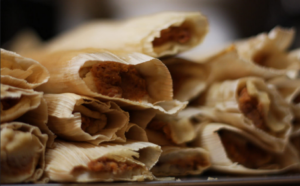
In the United States, when one hears the word tamale, it resonates as one of the quintessential foods that depict Mexican culinary culture. Along with enchiladas, burritos and margaritas; tamales tend to bring images of steaming masa and aromatic teases of their mysterious fillings into focus. Yet as we will come to realize, tamales vary and truly span Latin America and the world.
It’s very common to go into most Mexican restaurants and order tamales at any time of the year (after the obligatory basket of chips and salsa) yet in reality tamales are not a daily item on the family menu for dinner. The preparation of tamales can be quite laborious and systematic as there is sequential symphony that needs to take place to get them completed. From preparation of the masa (a thick batter that encases whatever filling is opted for), soaking the corn husk which is what the delicate package is wrapped in, preparation of the filling which can be essentially anything one can imagine (meats, seafood fruits, vegetables or nothing at all). An assembly line of husks, masa and fillings is assembling proximal to a large stock pot with boiling-hot water which will serve as the steaming vessel for the assembled tamales.
Due to the laborious nature of tamales, one could say that they are seasonal or reserved for special occasions. So typically one finds the preparation and enjoyment of tamales around the fall holidays of Christmas and New Year (and thanksgiving in the United States). So was the case in my family in which tamales would be prepared with precision and efficiency by my mother and five sisters when a festivity was at hand. An interesting story that my mom would commonly tell right around my birthday involved tamales. A sister’s birthday is the day before mine so apparently for her ninth birthday my mother had made tamales for the birthday party and once the party was over of course clean-up ensued. Needless to say my mother wasn’t able to completely clean-up her kitchen to her liking being that I “decided to start my arrival later that night”. So ever since then, besides having consecutive birthdays, we also shared a story related to tamales.
Again, most people enjoy tamales as a Mexican dish but in reality they are a food that originated in Mesoamerica and span the world in various iterations. Tamales were enjoyed by several pre-Hispanic cultures such as the Aztecs, Maya, Olmeca and Tolteca. Easily portable, due to their husk encasing, they were the ideal meal for taking on their army expeditions, hunting trips or migratory odysseys. Ingredients typically included such oddities as iguana, deer, peacock and the likes. Towards the southern areas of Mexico (such as Oaxaca and Chiapas) and into Central America, tamales are essentially the same (masa, filling, and wrapped) but vary in their wrapper; in place of corn husk are banana leaves. This gives the masa a different texture and subtle flavor. As one investigates further into South America, that region also has their version of tamales. Tamales Salteños are found in Argentina, sweet Humita are found in Peru, Argentina, Ecuador and Bolivia. Brazil has pamonha and Venezuela has hallacas. Most surprising to me was that the Phillipines also has a variation of tamales called Binaki which include fillings of chicken, pork and peanuts but the masa is made of rice flour and not the traditional corn meal masa. This was in part due to the many years of Spanish rule and being governed as a Mexican province.
If any of you are looking for recommendable tamale establishements, recommended is Maria’s Tamaleria in Lynwood where you can find a variety of prepared tamales or a local farmens market such as Torrance City Farmers Market . ¡Buen Provecho!Tamales

Hi Hugo, I definitely agree that tamales are very laborious. My Mexican friends would invite us over during “tamale season” when the toiling of tamales was blissfully achieved by many worker bees in the kitchen; each helper having their own specific task to bring the batch of tamales to conclusion. They made tamales for the holidays and for special occasions. The process started around 1 PM in the afternoon and at around 8 PM, the tamale batches, sometimes numbering up to 100, were prepared and ready to be dispersed, frozen and consumed.